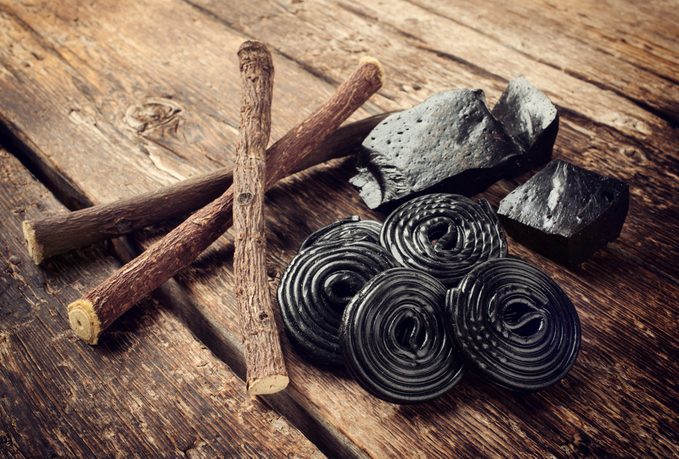Natural Health Remedy: The Benefits of Licorice Root
The health benefits of licorice root are astounding; it’s time we stop thinking of it as a candy ingredient and start taking it seriously

Source: The Amazing Healing Powers of Nature, Reader’s Digest
Learn about the health benefits of licorice root
When you think of licorice you probably think of a sweet red chewy candy stick, or maybe the anise-flavoured black licorice we all seem to either love or hate. A real old-fashioned licorice stick is actually the dried root of the licorice plant. Sink your teeth into one and what happens next just might surprise you.
Hidden inside is a super-sweet compound called glycyrrhizin. This and dozens more chemicals lend this ancient herb its healing medical potential. For thousands of years, licorice has had a well-deserved reputation for soothing irritations such as sore throats and upset tummies and relieving congestion. Now it appears it might also have other, yet more powerful properties, though there are a few downsides worth noting, too.
So what are some of the health benefits? Licorice (Glycyrrhiza glabra) is used to treat indigestion, hepatitis C, memory loss, cancer and skin infections. Traditionally it was used as treatment for stomach ulcers, heartburn, indigestion, toothache, fever, asthma, bronchitis and coughs, too.
How to take licorice root as a supplement
Peeled licorice root is available in dried and powdered forms and as capsules, tablets and liquid extracts. The safest dose for most adults to get the full health benefits is 1 to 5 grams of licorice daily containing 1 to 10 milligrams of the active ingredient glycyrrhizin, for 4 to 6 weeks.
Note that in large amounts and in people with hypertension or heart, kidney or lung disease, licorice that contains glycyrrhizin can cause adverse reactions. Choosing deglycyrrhizinated licorice (DGL)’licorice with the glycyrrhizin removed’can lower the risk of serious side effects.
Stomach protection
For a time, licorice was considered a natural and effective remedy for stomach ulcers, after Dutch physician FE Revers used it to treat his patients. Intrigued, researchers in the 1950s discovered that licorice compounds worked by triggering the release of stomach-protecting mucus and by protecting the stomach’s lining from the ravages of pepsin, a powerful digestive enzyme.
It has since been shown, however, that long-term exposure to the glycyrrhizin in licorice can boost blood pressure, cause water and sodium retention and lower levels of potassium in the body, making it unsafe for extended use.
And although researchers in India have experimented successfully with a safer, glycyrrhizin- free licorice to ease ulcer pain, today most people take antibiotics to wipe out the bacteria that cause stomach ulcers, and most scientists have switched their attention to other exciting healing possibilities in licorice.
Stalling cancer
Can licorice stand up to cancer? A lab study conducted at India’s Roland Institute of Pharmaceutical Sciences in 2011 says yes. The compounds licochalcone-A, glabridin and licocoumarone halted the growth of or killed, breast cancer, prostate cancer and leukemia cells. Glycyrrhizin and glycyrrhizic acid also put the brakes on the formation of tumours in skin, colon, liver, uterine and breast cancers.
This use of licorice has not been widely tested in humans, but one herbal prostate-cancer formula that contained licorice, PC-SPES (which is no longer available), was shown in human studies to slow the progression of some prostate cancers. Certainly, licorice is no substitute for conventional cancer therapy, but scientists think it has potential.
Fighting infection
There are other health benefits being looked at into the future, too. It looks like licorice could be a mainstay in medicine’s arsenal of infection-fighters. A 2010 University of Texas study revealed that glycyrrhizin helps damaged skin create bacteria-fighting proteins called antimicrobial peptides, which are an important defense against infection. This could lead to treatments to counter antibiotic-resistant infections, such as those that sometimes occur in severe burns and can be fatal.
Perhaps most surprisingly, this sweet root could even be a dentist’s dream. Two licorice compounds, licoricidin and licorisoflavan A, have been shown, in lab studies, to kill off 2 major types of cavity-causing bacteria and 3 types of bacteria that fuel gum disease.
Anti-stress and anti-inflammatory effects
Licorice may be good for the brain, too. During a 2004 study at the University of Edinburgh, older men took a licorice extract containing the compound carbenoxolone and their verbal memory and fluency (the ability to put thoughts into words), improved. Why is that? Carbenoxolone seems to help by inhibiting a brain enzyme that helps make stress hormones, which contribute to age-related brain changes. Scientists say more research is needed but that a growing stack of lab research backs licorice’s potential for memory enhancement. In a mouse study, for example, animals that received licorice extract excelled at learning and memory tests.




